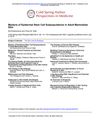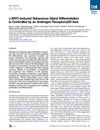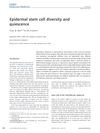BLIMP1 Is Required for Postnatal Epidermal Homeostasis but Does Not Define a Sebaceous Gland Progenitor Under Steady-State Conditions
September 2014
in “
Stem cell reports
”

TLDR BLIMP1 is essential for skin maintenance but not for defining sebaceous gland progenitors.
The study re-evaluated the role of BLIMP1 in the epidermis and found that, contrary to previous reports, BLIMP1 did not define a sebaceous gland progenitor population. Instead, BLIMP1 was expressed by terminally differentiated epidermal cells in the sebaceous gland, interfollicular epidermis, and hair follicle. Overexpression of c-Myc led to the loss of BLIMP1+ cells, influenced by androgen signaling. Deleting Blimp1 in the epidermis caused differentiation defects and sebaceous gland enlargement. BLIMP1+ sebocytes did not show higher clonogenic potential than BLIMP1− sebocytes in culture. Lineage-tracing showed that BLIMP1-expressing cells did not divide under steady-state conditions, indicating BLIMP1's role in maintaining homeostasis in differentiated cells rather than acting as a progenitor marker.









